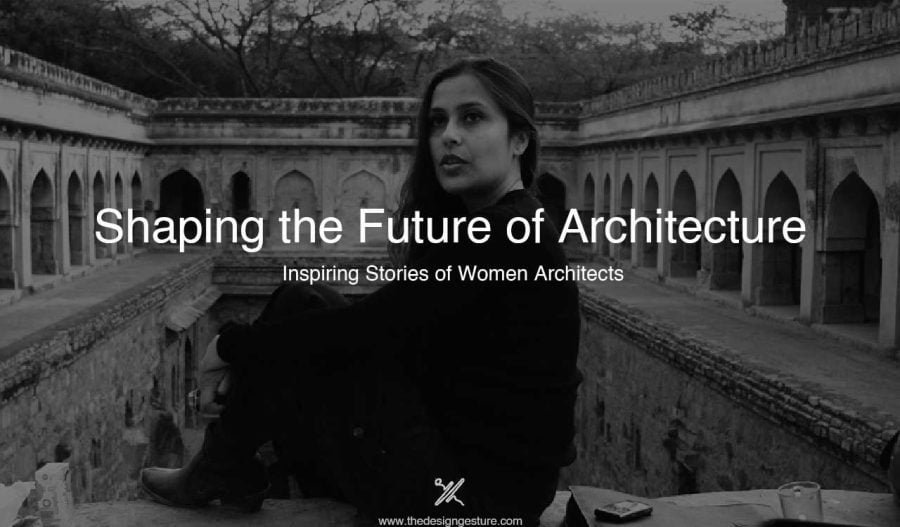Table of Contents
Introduction
In the dynamic field of architecture, some people are notable for their inventiveness and environmentally conscious practices. In addition to shaping skylines, these four extraordinary architects—Brinda Somaya, Sheila Sri Prakash, Revathi Kamath, and Marina Tabassum—have also woven a tapestry of tradition and sustainability into their architectural legacies.
Brinda Somaya: An Architect Weaving Tradition and Sustainability
Born on June 28, 1949, Brinda Somaya’s journey began with a strong educational foundation. Her early years were spent in the science department at the Cathedral & John Connon School, where her love of architecture started to take shape. She attended the Sir J.J. School of Architecture in Mumbai as part of her educational journey before attending Smith College in Northampton, Massachusetts, where she earned a Master of Arts degree.
Brinda Somaya embarked on her architectural career in Mumbai in 1978, founding her firm in a modest office tucked away in her garden.
Her company emerged victorious in the competition for the Indian Institute of Management, Ahmedabad’s historic Louis Kahn buildings’ restoration and enhancement.
Mumbai’s St. Thomas’ Cathedral. The Leading European Architects Forum award was given to her for her work on the Nalanda Schools Campus in Baroda.
Other accolades include the Vassilis Sgoutas Prize for the rehabilitation of Bhadi Village, the AYA JK Cement Award, and the Indian Institute of Architects’ Kitply Award for Conservation.
Her distinguished career also earned her the Indian Institute of Architects – Baburao Mhatre Gold Medal for Lifetime Achievement, and she was designated as a Distinguished Professor by the Indian Education Society’s College of Architecture, Mumbai.
Part of Brinda Somaya’s architectural legacy includes her work in the earthquake-affected village of Bhadli, where she oversaw the reconstruction efforts.
Another remarkable project was the restoration of the St. Thomas Cathedral, the oldest Anglican Church in Mumbai. Her use of Her choice of regional brick and design cues was inspired by Jaipur’s heritage.
Other projects include the Goa Institute of Management, the Birla Institute of Technology and Sciences in Pilani, Zensar Technology Limited in Pune, TCS House in Mumbai, and the rehabilitation of Bhadli Village, including its school and community center. She also led the restoration of the Indian Institute of Management – Ahmedabad (IIM-A) Louis Kahn Campus.
Brinda Somaya’s journey has been intertwined with her personal life. She has been married to Anand Somaya, a cardiac surgeon, for over 42 years, demonstrating the ability to balance a successful career with a fulfilling personal life.
Sheila Sri Prakash: Pioneering Architect and Urban Designer
Born in Bhopal, India, on July 6, 1955, Sheila Sri Prakash’s early years and the history of art shaped her journey.
Her parents are S. Thangamma and Lt. Col. G. K. S. Pathy, who are both Indian Army officers. Her journey as a gifted artist began with her introduction to Bharatanatyam at the tender age of four. She later moved to Chennai to pursue her passion and was mentored by prominent figures like Sri Dandayudha Pani Pillai and Vempati Chinna Satyam.
Educational Pursuits Despite societal biases against women entering the field of architecture, Sheila Sri Prakash’s determination led her to enroll in the Bachelor in Architecture program at the Anna University School of Architecture and Planning in 1973.
Sheila Sri Prakash stands out as one of India’s leading architects, boasting a portfolio comprising over 1200 architectural projects. As a founding member of the Indian Green Building Council, her commitment to sustainable architecture is unmistakable. Notably, her restoration of the Brihadisvara Temple in Thanjavur exemplifies her dedication to preserving cultural heritage. This UNESCO World Heritage Monument underwent a rigorous process of evaluation before her firm, Shilpa Architects, was commissioned for the restoration.
Global Recognition and Contributions Sheila Sri Prakash made history by becoming the first Indian architect to serve on the World Economic Forum’s Global Agenda Council on Design Innovation.
Involvement with Zonta Known for her contributions to women’s empowerment, Sheila Sri Prakash actively participated in Zonta International, an organization dedicated to enhancing the status of women globally.
Engaging actively in academia, Sheila Sri Prakash is frequently sought after to participate as a juror, providing insightful critiques at student charrettes conducted in colleges worldwide.
Recent Projects from Her firm, Shilpa Architects, Planners, and Designers, has been involved in a wide range of projects, including a LEED Platinum-rated office building, the HITEX exhibition center in Hyderabad, the South City Township by Larsen & Toubro, and the upcoming Taj 5-star beach resort near Pondicherry.
Revathi Kamath: Pioneering Mud Architect and Innovator
Revathi Kamath’s life journey began in 1955 in Bhubaneswar, Odisha.
She was raised in a Tamil Brahmin family and spent her early years in Bangalore and the tribal regions along the Mahanadi River. Her father’s work on the Hirakud dam as an engineer deeply influenced her understanding of nature, people, and the rhythms of life.
Revathi Kamath’s educational path led her to obtain a Bachelor’s degree in Architecture in 1977. She furthered her studies by completing a post-graduate program in Urban and Regional Planning in 1981, both at the School of Planning and Architecture in Delhi. After her graduation, she gained experience working with architectural firms such as Stein, Doshi Bhalla, and Rassik International, Architects, and furniture designers. In 1979, she joined The GRUP (Group for Rural & Urban Planning), a partnership firm, and later worked for the National Institute of Urban Affairs. Her commitment to education extended to her roles as a visiting faculty member (1984–87) and an assistant professor (1987–91) at the School of Planning and Architecture, New Delhi.
In 1981, Revathi Kamath co-founded the firm “Revathi and Vasant Kamath” with Vasant Kamath, which evolved into “Kamath Design Studio – Architecture, Planning, and Environment” in 2005. Her studio undertook a diverse range of projects, catering to different social, economic, and geographical contexts. Notably, the Anandgram Project in 1983, aimed at rehabilitating slum dwellers near Shadipur Depot, showcased her commitment to creating an “Evolving Home” concept for redevelopment. She closely collaborated with 350 families to meet individual needs and provide them with their first ground-level homes.
Revathi Kamath’s architectural brilliance earned her three nominations for the Aga Khan Award. Her nominated projects include the Akshay Pratishthan School in Delhi, the Community Center at Maheshwar, and the Nalin Tomar House at Hauz Khas, Delhi.
Contributions to Exhibitions: Revathi contributed to the “Traditional Architecture in India” exhibition for the Festival of India in Paris in 1986. She played a vital role in the design team for the Eternal Gandhi Multimedia Museum and co-curated and designed the exhibition “Craft: A Tool for Social Change” for VHAI (Voluntary Health Association of India) in 2003.
Her extensive portfolio encompasses diverse projects, including a Desert Resort in Mandawa, Rajasthan, a Mudhouse for Nandita and Amit Judge in Delhi, and the Jivashram animal shelter in Delhi. Her architectural vision encompassed the Jindal Power Limited VIP Guest House in Raigarh, the Jindal Power Plant Gateway in Tamnar, Chhattisgarh, and the Kamath House in Anangpur.
Among her notable projects are the Museum for Tribal Heritage in Bhopal, the Tal Chhapar Sanctuary for the Government of Rajasthan, and the Auditorium at Raigarh.
Revathi Kamath’s architectural journey included ongoing projects like the Gnostic Centre in Delhi.
In 2018, Revathi Kamath received the prestigious World Women in Arts, Architecture, and Design (WADe Asia)—Sustainability Award.
Marina Tabassum: Shaping a Sustainable Architecture Legacy
Marina Tabassum’s architectural journey began in Dhaka, Bangladesh. Her family’s departure from India during Bengal’s 1947 partition, when she was born in 1968 or 1969, greatly influenced her distinct viewpoint. She attended Holy Cross Girls School and College before embarking on a degree in architecture at the Bangladesh University of Engineering and Technology in 1994.
Tabassum’s career in architecture has been marked by innovation and social consciousness. In 1995, she co-founded URBANA, an architectural practice based in Dhaka, with Kashef Chowdhury.
Marina Tabassum’s architectural legacy includes a series of remarkable projects:
Museum of Independence (1997-2006): Located in Dhaka, Bangladesh, this museum stands as a symbol of the nation’s rich history and struggle for freedom.
A5 Residence (2001): Another addition to Dhaka’s architectural landscape, this residence reflects Tabassum’s commitment to blending modernity with local aesthetics.
Comfort Reverie (2006-2011): Situated in Dhaka, this project showcases Tabassum’s knack for creating spaces that balance comfort and contemporary design.
Baitur Rouf Mosque (2012): A crowning achievement, this mosque in Dhaka reflects her architectural prowess and won the prestigious Aga Khan Award for Architecture in 2016.
Panigram Eco Resort and Spa (2018): Located in Jashore, Bangladesh, this resort exemplifies Tabassum’s dedication to sustainable architecture.
Khudi Bari (2020): Designed for the coastal areas of Bangladesh, this project addresses the challenges posed by climate change and coastal living.
The contributions made by Marina Tabassum to architecture have not been overlooked. She has received numerous awards, recognizing her significant impact on the field:
First prize for the Independence Monument and the Liberation War Museum, awarded by the Bangladeshi Prime Minister Sheikh Hasina in 1997.
Architect of the Year Award in 2001, presented by the Indian Vice President Bhairon Singh Shekhawat.
Anannya Top Ten Awards in 2004, cementing her place among Bangladesh’s top architects.
Finalist of the Aga Khan Award for A5, a pavilion apartment, in 2004, marking her presence on the global architectural stage.
Her ability to think creatively was demonstrated in 2006 when she placed second in the Nishorgo Architectural Competition.
The Aga Khan Award for Architecture, one of the highest recognitions in the field of architecture, was given out in 2016.
awarded the 2021 Arnold W. Brunner Memorial Prize in honor of her exceptional achievements.
Lifetime Achievement Award in 2022, as she became the 1st South Asian to receive the “Lisbon Triennale Lifetime Achievement Award.” This prestigious recognition from the Lisbon Architecture Triennale panel signifies the lasting impression she has made on the world of architecture.
Conclusion
Revathi Kamath, Sheila Sri Prakash, Brinda Somaya, and Marina Tabassum—four exceptional women—personify the profound influence architecture can exert, each crafting a unique narrative of metamorphosis. Their enduring legacy extends beyond the confines of architecture, profoundly enriching the cultural, social, and environmental fabric of the locations where their visionary commitment to tradition, sustainability, and inventive design has left an indelible mark.
I.e. Honouring their achievements makes it clear that their architectural endeavors represent a commitment to balancing the built environment’s past, present, and future rather than just creating physical structures.




